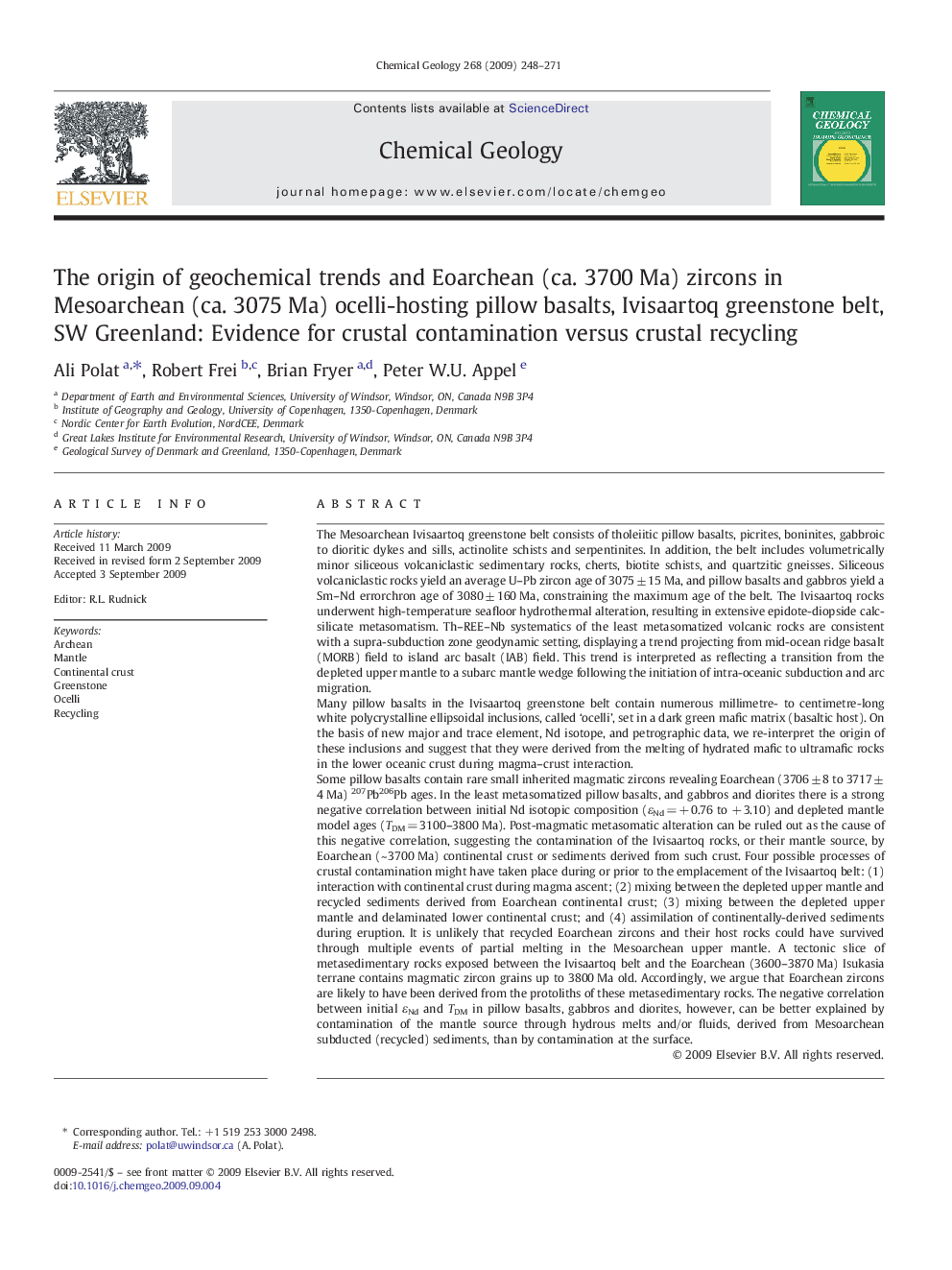| کد مقاله | کد نشریه | سال انتشار | مقاله انگلیسی | نسخه تمام متن |
|---|---|---|---|---|
| 4700103 | 1637697 | 2009 | 24 صفحه PDF | دانلود رایگان |

The Mesoarchean Ivisaartoq greenstone belt consists of tholeiitic pillow basalts, picrites, boninites, gabbroic to dioritic dykes and sills, actinolite schists and serpentinites. In addition, the belt includes volumetrically minor siliceous volcaniclastic sedimentary rocks, cherts, biotite schists, and quartzitic gneisses. Siliceous volcaniclastic rocks yield an average U–Pb zircon age of 3075 ± 15 Ma, and pillow basalts and gabbros yield a Sm–Nd errorchron age of 3080 ± 160 Ma, constraining the maximum age of the belt. The Ivisaartoq rocks underwent high-temperature seafloor hydrothermal alteration, resulting in extensive epidote-diopside calc-silicate metasomatism. Th–REE–Nb systematics of the least metasomatized volcanic rocks are consistent with a supra-subduction zone geodynamic setting, displaying a trend projecting from mid-ocean ridge basalt (MORB) field to island arc basalt (IAB) field. This trend is interpreted as reflecting a transition from the depleted upper mantle to a subarc mantle wedge following the initiation of intra-oceanic subduction and arc migration.Many pillow basalts in the Ivisaartoq greenstone belt contain numerous millimetre- to centimetre-long white polycrystalline ellipsoidal inclusions, called ‘ocelli’, set in a dark green mafic matrix (basaltic host). On the basis of new major and trace element, Nd isotope, and petrographic data, we re-interpret the origin of these inclusions and suggest that they were derived from the melting of hydrated mafic to ultramafic rocks in the lower oceanic crust during magma–crust interaction.Some pillow basalts contain rare small inherited magmatic zircons revealing Eoarchean (3706 ± 8 to 3717 ± 4 Ma) 207Pb206Pb ages. In the least metasomatized pillow basalts, and gabbros and diorites there is a strong negative correlation between initial Nd isotopic composition (εNd = + 0.76 to + 3.10) and depleted mantle model ages (TDM = 3100–3800 Ma). Post-magmatic metasomatic alteration can be ruled out as the cause of this negative correlation, suggesting the contamination of the Ivisaartoq rocks, or their mantle source, by Eoarchean (~ 3700 Ma) continental crust or sediments derived from such crust. Four possible processes of crustal contamination might have taken place during or prior to the emplacement of the Ivisaartoq belt: (1) interaction with continental crust during magma ascent; (2) mixing between the depleted upper mantle and recycled sediments derived from Eoarchean continental crust; (3) mixing between the depleted upper mantle and delaminated lower continental crust; and (4) assimilation of continentally-derived sediments during eruption. It is unlikely that recycled Eoarchean zircons and their host rocks could have survived through multiple events of partial melting in the Mesoarchean upper mantle. A tectonic slice of metasedimentary rocks exposed between the Ivisaartoq belt and the Eoarchean (3600–3870 Ma) Isukasia terrane contains magmatic zircon grains up to 3800 Ma old. Accordingly, we argue that Eoarchean zircons are likely to have been derived from the protoliths of these metasedimentary rocks. The negative correlation between initial εNd and TDM in pillow basalts, gabbros and diorites, however, can be better explained by contamination of the mantle source through hydrous melts and/or fluids, derived from Mesoarchean subducted (recycled) sediments, than by contamination at the surface.
Journal: Chemical Geology - Volume 268, Issues 3–4, 30 November 2009, Pages 248–271